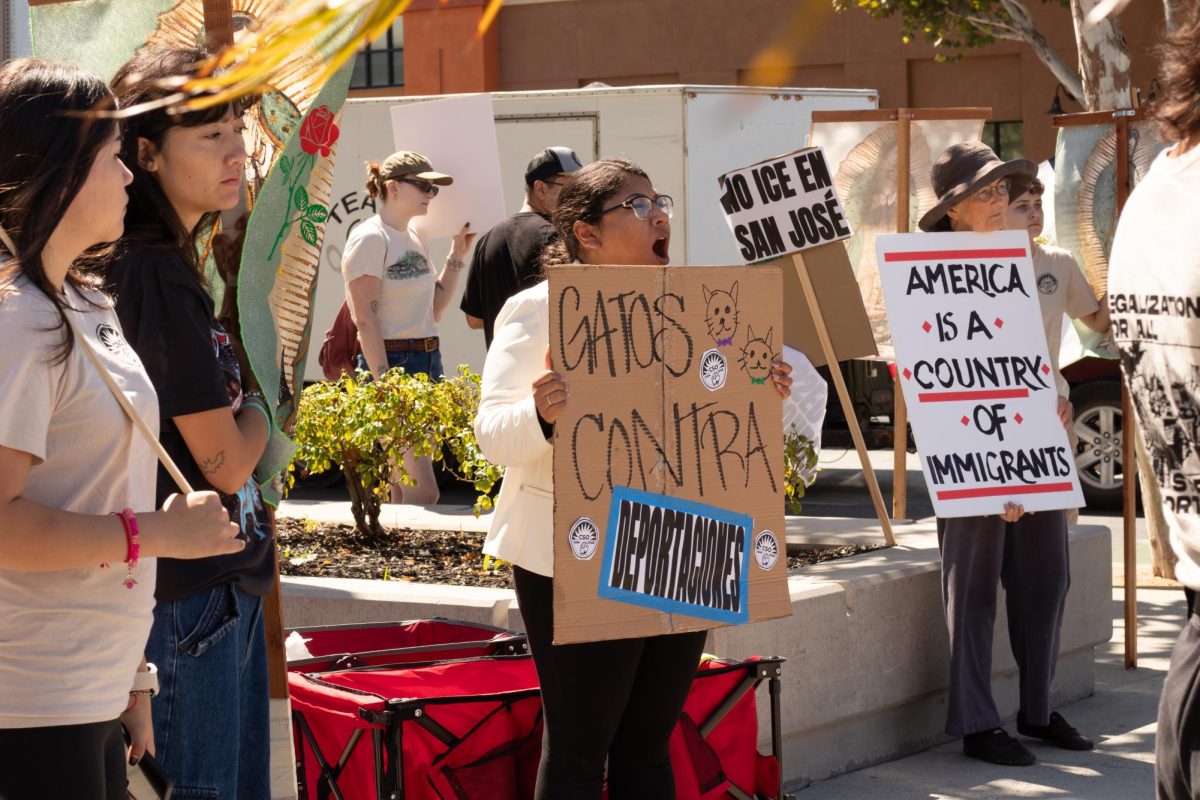
Ashley Kang
Brisa Moreno, chief of staff for San José Councilmember Peter Ortiz, holds a sign protesting ICE operations on Sunday.
On Sunday, dozens of community members gathered in East San José to protest a Sept. 8 Supreme Court ruling that lifted restrictions on federal immigration enforcement tactics.
The emergency order, which passed 6-3, allowed Immigration and Customs Enforcement agents to resume conducting stops based on factors such as race, language, job and location, according to a Sept. 8 Associated Press article.
Brisa Moreno, chief of staff for San José city councilmember Peter Ortiz, said the ruling opened the door to racial profiling by immigration enforcement officers in San José.
“This ruling is more than a legal setback,” Moreno said. “It is a direct attack on the dignity, safety and humanity of our immigrant neighbors. Racial profiling divides communities, destroys trust and inflicts harm on families who are simply trying to live, work and thrive.”
In July, the use of such tactics by immigration enforcement officials had been found unconstitutional by a U.S. District Court in Los Angeles, according to a Sept. 8 article by CalMatters.
Justice Sonia Sotomayor, who was joined by Justices Elena Kagan and Ketanji Brown Jackson in her dissent, wrote that shifting the burden on citizens to provide proof of legal residence, rather than requiring the government to prove reasonable suspicion for making stops, would amount to “the creation of … a second-class citizenship status.”
“Countless people in the Los Angeles area have been grabbed, thrown to the ground, and handcuffed simply because of their looks, their accents, and the fact they make a living by doing manual labor,” Sotomayor wrote. “Today, the Court needlessly subjects countless more to these exact same indignities.”
Felipe Romero, a staff attorney at Human Agenda, said the ruling erodes Fourth Amendment protections against unreasonable searches and seizures.
“It (the amendment) is a vital safeguard against overreach and abuse by the state,” Romero said. “But the Supreme Court has opened the door for increased racial profiling and discriminatory policing under the guise of immigration enforcement.”
Human Agenda, an immigrants’ rights advocacy group in San José, is part of Santa Clara County’s Rapid Response Network, according to a Sacred Heart Community Service webpage.
Romero works under the Colectivo Legal Accesible Razonable y Organizado branch of Human Agenda, which provides free or low-cost legal services to residents of Santa Clara County, according to its webpage.
Members of Community Service Organization San José, a local grassroots organization focused on advancing immigrant and Chicano rights in San José, held the protest in support of the city’s undocumented residents.
“With so much news happening all at once, it’s very scary,” said Jessica Aviles, a member of the organization. “Some people might not even know of the (Supreme Court) ruling yet because they’re just scared.”
Since January, fears of deportation by ICE have kept students away from schools and summer programs in San José, according to an Aug. 6 article by San José Spotlight.
In Santa Clara County, which has the highest concentration of immigrants in California, 60% of children have at least one foreign-born parent, according to data from the County Office of Education.
“(East San José) is a predominantly Chicano, Mexican, immigrant community,” Aviles said. “That’s why we chose this location (on the corner of King and Story roads), to show people that people are standing up, that they’re not alone, and that we can all do this together.”
An unmarked vehicle that belonged to ICE was sighted behind a Target on King and Story roads earlier this year, according to a Jan. 28 article by the Spartan Daily.
Another sighting occurred between Alum Rock and South Jackson avenues, according to the same source.
Though San José hasn’t had ICE operations at the scale of those in Los Angeles or Chicago, Moreno said the impacts of ICE activity have been palpable.
“We’re already seeing a lot of impact on our businesses, like in Tropicana, because people aren’t coming out anymore,” Moreno said. “They’re scared of either getting picked up or just disappearing.”
Councilmember Ortiz, alongside councilmembers Pamela Campos, David Cohen and Rosemary Kamei, introduced a policy that would prohibit ICE agents from concealing their identities or wearing masks while conducting enforcement activities in San José, according to a July 24 article by San José Spotlight.
The proposal passed the Rules and Open Government Committee by a unanimous vote on Sept. 10.
If approved by the city council, the unmasking mandate would make San José one of the first municipalities in the nation to regulate federal law enforcement agents in this way, according to a Sept. 10 article by KTVU FOX 2.
“This is one way we are fighting back (the Trump administration), by demanding transparency, accountability and respect for the people that we represent,” Moreno said. “We know this fight is bigger than one ordinance or one city, but we also know real change starts locally.”
On Saturday, California Governor Gavin Newsom signed a bill prohibiting federal agents and other law enforcement officials from covering their faces in California, according to a Sept. 20 article by The New York Times.
Isaac Banuelos, a lifelong resident of San José, said it was his second time coming out to a protest.
“Everybody’s out here trying to help each other, which is good. My girlfriend’s out here too, and knowing her status, (the ruling) is not okay,” Banuelos said. “It put me in perspective that it could be anybody.”